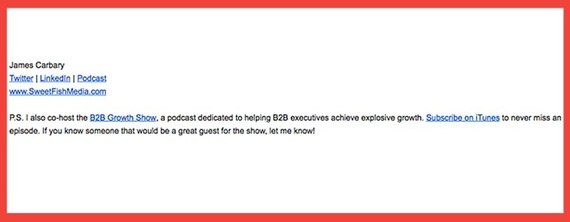If you're only using email to communicate with your customers, you're missing out on a valuable piece of marketing real estate.
Signature marketing makes use of the white space under your email signature to promote an event, product, blog, video--any content you want to direct your customers to via an icon and link.
Dan Hanrahan, founder of Sigstr, recently shared with us more about his company, which provides businesses with a tool to roll out company wide marketing campaigns via email signatures. Here's what Dan had to say about how any company can get started utilizing this high-exposure form of marketing.
Be Consistent
Standardized signatures are the foundation for you to lay your signature marketing plans on. (Click to tweet)
Your email signature is the digital equivalent of a paper business card, so it makes sense that everyone within your business should have the same style of signature. You wouldn't let a new employee design their own business card, with free license to use your logo, and an email signature should be treated the same.
Having total buy-in from your employees is, ultimately, vital to the success of your future signature marketing campaigns, and consistent company-wide signatures should be implemented before trying to add marketing features to it.
A simple HTML template with a standardized signature is the best place to start and is the easiest to share with new and existing staff. If you have the budget, it's worth getting a pro to do this to ensure your links are handled correctly and compatible across different platforms. It will save you frustration later on.
Make a Plan
On average, every person in your company is sending 28 emails per day. In a company of 100 employees, that works out to a staggering 1+ million emails sent, being viewed 2,555,000 times, every year! Even with a click rate of .5%, you're still looking at 12,775 connections outside of your normal marketing channels.
Putting a plan in place of how and when and what you want to promote will ensure you take full advantage of a staggering amount of new engagement.
Here are a few things to consider:
- If you are unsure and want to test the waters, ask yourself this: what's the one big event, product, or bit of content you can link to to start with?
- Is your content more suited to being marketed by department or by every employee across the business? Will it vary depending on the project?
- Make a list of events, case studies, blogs--everything you want to promote--and start to work them onto a calendar.
It doesn't need to be elaborate. It could be as simple as a banner that links to your website with the full content. If it's part of a larger campaign with artwork, ask the designer to include an email-appropriate banner size in your design package, keeping it in line with the same size as your corporate signature.
Centralize Control
When you first start, it might be appropriate for your marketing team to send a company-wide email with an HTML attachment and instructions for adding the content below their signature.
If you're fortunate enough to have an HTML-savvy IT member, you could also place control under your IT department, which can assist with the roll out. At the end of the day, you still want consistency and correct implementation, so centralizing control of both the signature and signature marketing narrows your margin of stragglers who can't seem to get it.
There are also tools, such as Sigstr, that specifically help companies with both. If your future plans look to be fairly complicated, with different content for different departments, working on their own schedules, it's worth exploring the functionality of these tools.
Sigstr, in particular, covers the process from start to finish--from creating and implementing your standardized signature, to adding your custom marketing banners, to providing comprehensive analytics showing the effectiveness of the campaign from email clicks.
Conclusion
The best thing about signature marketing is how you can take one of your greatest means of communication and double it up as a marketing channel. Emails have to be sent, and the inclusion of an additional means of content and brand engagement is (almost) like getting free marketing.
You can find this interview, and many more, by subscribing to the B2B Growth Show on iTunes. If you don't use iTunes, you can listen to every episode by clicking here.


